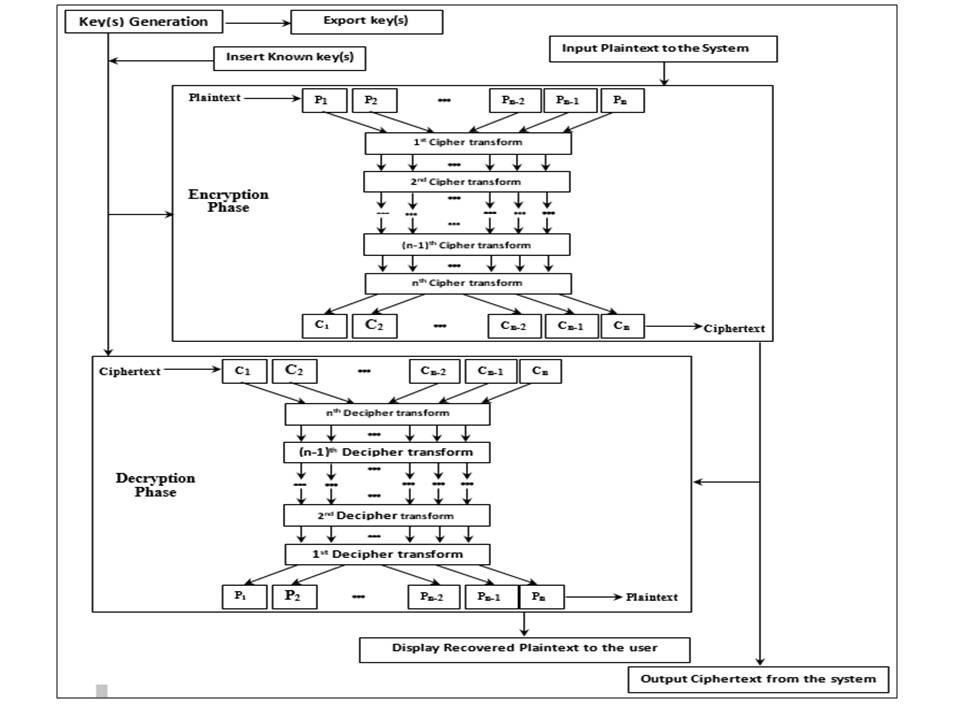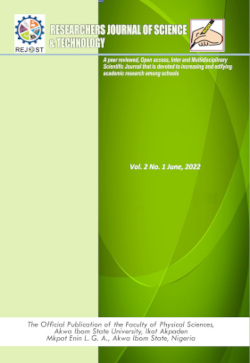Comparative Analysis of Different Multilevel States for Four Notable Cryptographic Schemes
Keywords:
Multilevel encryption, Elliptic-Curve Cryptography, Digital Encryption Standard, Advanced Encryption Standard, Comparative AnalysisAbstract
Multilevel cryptography refers to the use of multiple layers of encryption algorithms and keys to protect sensitive data and communications. The output of the encryption at the first layer becomes an input to the second encryption algorithm. The output of the second encryption algorithm becomes an input to the third encryption algorithm, and so on until the desired layers are satisfied. Suchamultileveled approach might be implemented using the same or different encryption algorithms.In this article, we conducted an extensive examination of different possible combinations of symmetric-key (Advanced Encryption Standard, (AES) and Digital Encryption Standard, (DES)) and asymmetric-key (Rivest, Shamir, and Adleman cryptography, (RSA) and Elliptic-Curve Cryptography, (ECC)) cryptosystems for data encryption and security byusing questionnaires. Comparative assessments of performance, scalability, computational complexity, memory requirements, and hardware optimization capabilities were carried out to identify the strengths and weaknesses in a combined state. Some key performance metrics such as speed, throughput, and resource utilization were determined per scheme implementation using an experimental platform to complement the theoretical analysis. Examinations of known cryptanalytic attacks, susceptibility to quantum attacks, and real-world vulnerability trends evaluated the security resilience of the systems. Factors such as implementation challenges, key management, standardization status, and adoption in practice were considered from an application perspective. A prototype general architecture for multilevel cryptosystem that can withstand any blind cryptanalytic attack was presented. Result shows that there is better performance in terms of encryption and decryption when AES is multileveled with RSA in contrast to DES performance with either RSA or ECC. Furthermore, ECC frequently surpasses RSA in speed for asymmetric cryptographic tasks owing to its utilization of shorter key lengths to achieve comparable security levels. Nevertheless, real-world performance may fluctuate depending on implementation intricacies and the capabilities of specific hardware. Using multilevel encryption algorithms gives a better assurance to information safety as it shows more proof against cryptanalytic attack.
References
Adebayo, O. S., Olalere, M., Mishra, A., Mabayoje, M. A., & Ugwu, J. N. (2014). N-Cryptographic Multilevel Algorithm for Effective Information Security.
Ahmed, S.H., Abuadbba, A., Alfandi, O., Abd elmonem, A., & Kim, H. (2020). Toward multilevel data security in cloud computing using a decentralized identity-based cryptography. Sensors, 20(14), 3858.
Alabi, O., Gabriel, A. J., Thompson, A., & Alese, B. K. (2022). Privacy and Trust Models for Cloud-Based EHRs Using Multilevel Cryptography and Artificial Intelligence. In Artificial Intelligence for Cloud and Edge Computing (pp. 91-113). Cham: Springer International Publishing.
Alexan, W., Alexan, N., & Gabr, M. (2023). Multiple-layer image encryption utilizing fractional-order chen hyperchaotic map and cryptographically secure prngs. Fractal and Fractional, 7(4), 287.
Almoysheer, N., Humayun, M., & Jhanjhi, N. Z. (2021). Enhancing Cloud Data Security using Multilevel Encryption Techniques. Turkish Online Journal of Qualitative Inquiry, 12(3).
Bhaskar, S. C. V., & Gopal, J. V. (2019, November). A constructive multilevel security system with cryptographic techniques by using cyber-physical system in the space/defense applications. In Proceedings of the 2019 2nd International Conference on Computational Intelligence and Intelligent Systems (pp. 122-128).
Chaudhry, J., & Kapoor, B. (2020). A novel approach for enhancing cloud security and compliance management. Journal of Information Security and Applications, 55, 102664. Dixit, A., Kumar, N., Arya, K.V., &Savidas, A. (2018). Relationship aware layered approach for securing data in cloud computing. Procedia Computer Science, 132, 1781-1790.
Chaudhry, J., & Kapoor, B. (2020). A novel approach for enhancing cloud security and compliance management. Journal of Information Security and Applications, 55, 102664.
Chen, Rui & Shi, Jia & Yang, Lie-Liang & Li, Zan & Guan, Lei. (2020). High-Security Sequence Design for Differential Frequency Hopping Systems. IEEE Systems Journal. PP. 1-12. 10.1109/JSYST.2020.3018115.
Dixit, A., Kumar, N., Arya, K.V., &Savidas, A. (2018). Relationship aware layered approach for securing data in cloud computing. Procedia Computer Science, 132, 1781-1790.
Fagbuagun, A. O., Daramola, C. Y., Ugwu, J. N. (2020). Template Matching Technique Based on Correlation Analysis ror Recognition of Nigerian Vehicle License Plate Using Edge Detection. FUOYE Journal of Pure and Applied Sciences. Vol 5(1) pp 135-147
Godfry, B. (2019). Multilevel security for industrial control systems. Electronics, 8(1), 92-102.
Jasuja, A.K., Jain, P.K., Bhandari, A., & Chauhan, R. (2020). A layered security algorithm for data security in cloud computing. Procedia Computer Science, 167, 987-995. https://doi.org/10.1016/j.procs.2020.03.439
Jasuja, A.K., Jain, P.K., Bhandari, A., & Chauhan, R. (2020). A layered security algorithm for data security in cloud computing. Procedia Computer Science, 167, 987-995. https://doi.org/10.1016/j.procs.2020.03.439.
Kumar, R., & Saha, R. (2023). Lightweight and secure data sharing scheme for eHealth systems in cloud computing environment. Journal of Information Security and Applications, 71, 103059. https://doi.org/10.1016/j.jisa.2022.103059
Kumar, S., Karnani, G., Gaur, M. S., & Mishra, A. (2021, April). Cloud security using hybrid cryptography algorithms. In 2021 2nd international conference on intelligent engineering and management (ICIEM) (pp. 599-604). IEEE.
Mishra, P., & Bajpai, A. (2015). Proposed efficient & secure image encryption scheme based on AES and SHA-2. Procedia Computer Science, 70, 717-725.
Sharma, P.K., & Dubey, A.K. (2017). Layered approach for improving cloud data security and performance. Procedia Computer Science, 125, 709-716.
Singh, N., Buyya, R., & Kim, H. (2024). Securing Cloud-Based Internet of Things: Challenges and Mitigations. arXiv preprint arXiv:2402.00356.
Sinha, R.K., & Kumar, P. (2021). A novel scheme for multilevel encryption of data on cloud environment. Materials Today: Proceedings, 46(7), 6045-6051.
Smith, A., Jones, B., & Johnson, C. (2022). Comparative analysis of multilevel cryptographic schemes for IoT networks. Journal of Cryptographic Engineering, 12(3), 165-178.
Suyal, A., Prasad, V., & Doja, M.N. (2017). Cascade encryption technique to secure data in cloud computing. Procedia Computer Science, 122, 788-795.
Tripathi, R., & Sinha, M. (2017). Integrated asymmetric and symmetric cryptographic scheme for cloud data security. Security and Communication Networks, 2017.
Thanki, R., & Kothari, A. (2021). Multi-level security of medical images based on encryption and watermarking for telemedicine applications. Multimedia tools and applications, 80(3), 4307-4325.
Verma, A.K., & Prasad, G. (2022). A systematic review on scalable and secure data sharing using blockchain in cloud computing. Journal of Network and Computer Applications, 189, 103231.
Zhang, X., Wuwong, N., Li, H., & Zhang, X. (2018). Information security risk management framework for the cloud computing environments. International Journal of Information Management, 40, 1-13.Vijay

Downloads
Published
How to Cite
Issue
Section
License
Copyright (c) 2024 Researchers Journal of Science and Technology

This work is licensed under a Creative Commons Attribution-NonCommercial-NoDerivatives 4.0 International License.




